Quick Summary:
Explore the diverse Data Migration Types with our expert data migration experts. Our comprehensive approach ensures a smooth data migration transition from storage to cloud. How can businesses leverage data migration types successfully? What data migration best practices? Uncover the answers to such questions and join us in the journey of Data Migration.
Did you know that over 80% of data migration projects exceed their planned time or budget? 30% of projects exceed the estimated costs, while 41% go beyond the initially set time frame.
According to the Industry Insights Guru report, The Global Data Migration Services Market Size Reached USD 12394.97 million in 2022, which is expected to grow at a CAGR of 19.44%. The Global Data Migration Services Market is forecasted to reach USD 35993.66 million from 2023 to 2031.
Organizations often seamlessly transition data from one system to another to enhance efficiency, optimize performance, and stay well-informed of technological advancements. Data Migration is a complex yet crucial part of information technology. It involves data transfer between different storage systems, formats or environments.
This data migration blog aims to explore the various types of data migration strategies organizations and IT professionals use. From data migration processes like storage migration to advanced endeavors like cloud migration, each data migration type plays a pivotal role in shaping the data infrastructure of organizations. Let’s begin this exploration as we disentangle the shades data migration and its diverse applications in this digital landscape.
Types of Data Migration
Data Migration can be broadly defined in the five categories. Let’s look at each of the data migration type in detail.

Storage Migration
Storage Migration Services simplifies the transfer of data to Windows Server or Azure, offering a graphical tool for Windows, Linux, and NetApp CIFS servers. It efficiently migrates data to newer servers or Azure virtual machines. Additionally, it enables seamless identity transfer, allowing apps and users to access data without altering links or paths, enhancing user experience.
Scenarios Where Storage Migration is Used:
- Upgrade Hardware
- Expand Capacity
- Refresh Technology
- Change the system or vendor
- Tier and Archive data
- Disaster Recovery Plan
- Data Center Consolidation
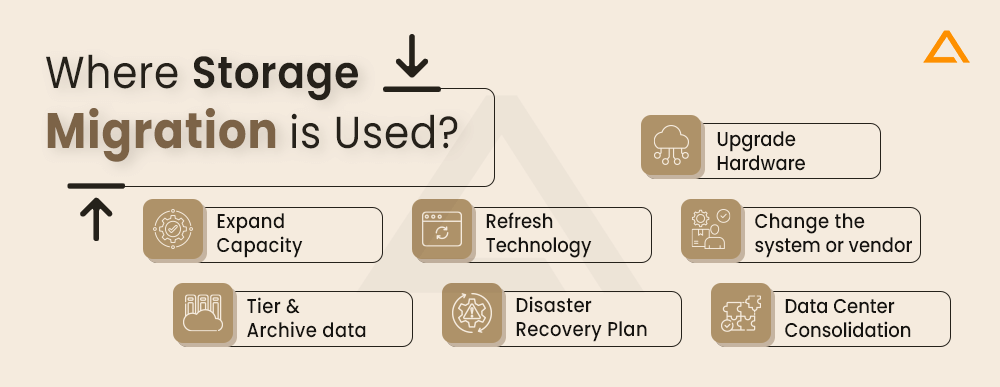
Companies Using Storage Migration:
- Netflix
- General Electric
- Dropbox
- NASA
- Spotify
Database Migration
Database Migration is key for upgrading technology or transitioning to the cloud. It can be a complicated process if you need to become more familiar with the concept. Here are two things that are included in the data migration process.
Homogenous migrations involve moving data within the same database types, ensuring the compatibly, and utilizing the tools such as SQL Server Integration Services for automation.
Heterogenous migrations between different database types, demand more translation work, including schema conversion & data mapping. Testing is vital component to ensure the accuracy, and careful planning is the key for a smooth and efficient migration process.
Scenarios Where Database Migration is Used:
- Technology Upgrades
- Data Warehouse Migration
- Security & Compliance
- Performance Optimization
- Cost Reduction
- Disaster Recovery Planning
- Data Center Relocation

Companies Using Database Migration:
- Amazon
- Microsoft
- Netflix
- Salesforce
- Bank of America
Application Migration
The process of relocating the software application between two computing environments is called application migration. It can be between two data centers or between on-premises server to a cloud provider. As the organizations are developed for specific systems or cloud platform, challenges are bound to be faced.
Migrating applications is typically more straightforward when transitioning from virtualized or service-based architectures compared to the complexity involved in migrating applications running on bare metal hardware. But while developing migration strategy it is important to keep in mind to assess each applications dependency, its technical requisites along with the security, cost consideration and compliance.
Application Migration Techniques
- Rehost
- Refactor/Re-architect
- Re-platform
- Retire/Replace
Scenarios Where Application Migration is Used:
- Technology Upgrade
- Data Center Relocation
- Cloud Adoption
- Cost Optimization
- Legacy System Optimization
- Disaster Recovery Planning
- Business Expansion
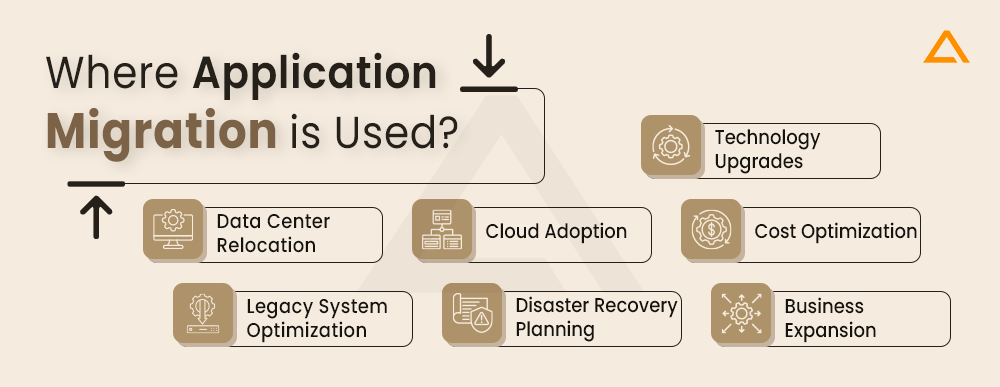
Sectors Where Application Migration is Used:
- Finance Sector
- Healthcare Industry
- Retail Companies
- Technology Companies
- Energy Sector
- Government Agencies
Cloud Migration
Cloud Migration is the process of transferring the digital assets, data, and applications from on-premises servers to the cloud. Cloud migration offers variety of benefits including optimized performance, lower maintenance cost & enhances collaboration. While migrating to cloud requires careful planning, assessing the existing systems requires careful planning, assessing the existing systems, and enables seamless transition to ensure a smooth and successful migration, ultimately improving overall efficiency & competitiveness.
Cloud Migration Techniques
Data Center Migration
This includes transitioning from on-premises data centers to cloud environments, optimizing the scalability, and reducing the infrastructure management burdens.
Hybrid Cloud Migration
This type of migration combines on-premises infrastructure with cloud resources. This migration offers flexibility and efficiency for organization with different computing needs.
Cloud-to-Cloud Migration
This Cloud migration involves moving the data and applications seamlessly between different providers. It allows business to choose optimal platforms for their evolving requirements.
Application Migration
This type of migration involves relocating the software applications to the cloud, ensuring the scalability, accessibility and enhanced performance.
Database Migration
Database Migration involves transferring databases to the cloud, optimizing data management & leveraging cloud services for enhanced functionality.
Mainframe Migration
The mainframe migration involves the transition from traditional mainframe computing to the cloud-based solutions, cost-efficiency, and exposing agility.
This strategy provides a significant for businesses aiming to enhance efficiency, cost-efficiency & leverage the benefits provided by the cloud computing.

Scenarios Where Cloud Migration is Used:
- Hybrid Cloud Adoption
- Data Center Consolidation
- Security Improvements
- Global Expansion
- Agile Development and DevOps
- Application Modernization
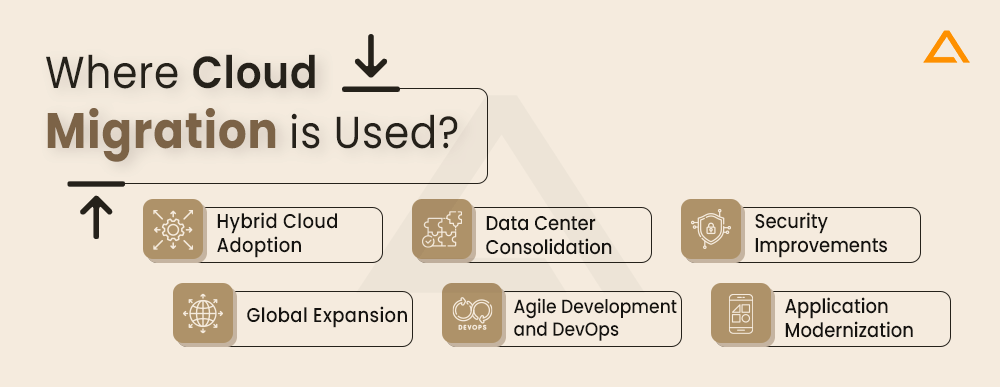
Scenarios Where Cloud Migration Is Used:
- Legacy System Modernization
- Business Continuity
- Hybrid Cloud Adoption
- Security Improvements
- IoT Integrations
Alright! We’ve covered the different types of data migration. Equipped with this information, let’s talk about the important stuff to remember while diving in the world of data migration.
Ready? Put your glasses on and let’s roll!
What Factors to Consider Before Data Migration?
There are several things that you need to consider before tarting your data migration journey. It is essential to the factors below in mind for smooth transitions.
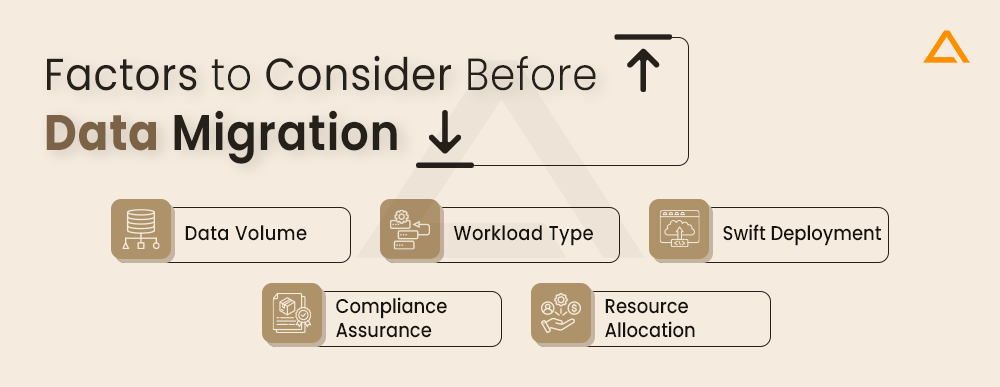
Data Volume
It is important to keep in mind that the larger datasets introduce more complexities, when you scale the data volume’s impact on the migration process. Apart from the potential stress of cost, resources and duration, there is also a high risk of data loss or data corruption. This highlights the facts that makes the need for careful planning of robust data backup and strong recovery strategies.
Workload Type
The key is understanding the specific task the new system will address. Whether it’s virtual machines (VMs), backups, or databases, adjusting your usage, storage, and capacity settings to accommodate this task is important This confirms that the post-migration phase is a seamless and efficient process works well.
Swift Deployment
While the goal of a quick migration timeline is admirable, it’s equally important to strike a balance. Consider the amazing resources and equipment available. A shorter timeline may require more resources or improved equipment, emphasizing the need to balance both speed and accuracy with efficiency in your migration process.
Compliance Assurance
Data protection and privacy laws is non-negotiable with compliance. Noncompliance can lead to legal penalties and loss of customer trust, particularly when dealing with sensitive or regulated information. Make sure that regulatory considerations are at the front of your migration strategy to navigate these potential drawbacks successfully.
Resource Allocation
Exploring resources requires more than just human resources available. Consider the team’s skillset and expertise, the migration equipment’s capabilities, and the allocated budget. All of these factors together shape your migration strategy and affect its success. A comprehensive understanding of the features of your project will enable you to implement them effectively, resulting in a smooth and successful migration journey.
What Leads to the Substantial Failure Rate in Data Migration Projects?
The astounding failure rate in data migration projects is rooted in several challenges, misconceptions, and complexities that organizations often take lightly. Some of the key factors contributing to this high failure rate are as follows:
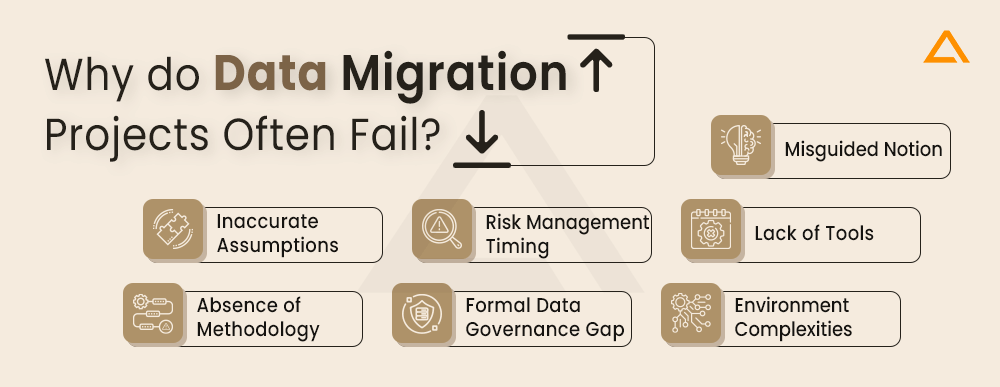
Misguided Notion & Inaccurate Assumptions
- Trusting that the data transformation is a straight-forward process
- Assuming that the data from the existing system will fit seamlessly in the new system
- Partial knowledge of data quality and required efforts
- Just focusing on business process modeling, not giving proper attention to the data support needs
- Assuming a complete, accurate, and well-written document for the current software state exists
- Thinking of data migration as a one-time process and taking it as a regular IT event that doesn’t affect the business
Risk Management Timing
- The delayed risk identification can often resurface as the loading failures in the target systems
- Load failure due to poor data quality and insufficient logic affecting migration
Absence Of Tools, Methodology and Formal Data Governance
- Often, migration is counted. Success was determined not only by input but also by ensuring accuracy and authenticity
- Traditional waterfalls struggle with the iterations of quality required to improve quality
- The lack of purposeful data quality technology hinders initial understanding and appropriate data cleansing
Environment Complexities
- The complexity of today’s surroundings overshadows the need for data focus
- Not realizing how crucial it is to handle data complexities in order for the goal system to provide the anticipated return on investment
In particular, the high failure rate in data migration projects is due to the underestimation of many aspects of the process, where organizations often struggle with misconceptions, subsequent risk management, inadequate governance and complexities.

Hey✋
Looking for Data Engineering Service? 👀🌟
Revolutionize Your Data Infrastructure with Cutting-Edge Engineering Services from Aglowid IT Solutions!
What are the Critical Elements for a Successful Data Migration?
A significant failure rate doesn’t necessarily imply inevitable failure for your data migration process. Having a proper successful data migration depends on several critical elements. They are as follows:

Thorough Planning
Building a data migration strategy with clear communication strategy, defined goals, and timelines with proper mention of data volume, potential challenges and complexities.
Detailed Data Assessment
Conducting the detailed analysis of current data to understand the structure, dependencies and quality for informed decision . It helps in identifying potential data issues and plan for any pitfalls.
Risk Management
It is important to develop an effective contingency plan by identifying and addressing the potential vulnerability in the early stage to be ready for any unexpected challenges and minimize the effects.
Data Quality Awareness
To guarantee the correctness and integrity of your data and raise its general quality, put a thorough procedure for data assessment and validation in place. You should also give priority to data optimization and filtering.
Maintain Proper Documentation
Maintain detailed documentation for reference and auditing purposes. The document should contain the current data state, the migration process you are following and any changes made during the migration process.
Stakeholder Involvement
It is important to foster the collaboration of key stakeholders from both IT and business departments to ensure that the organization’s objectives are aligned to address any specific business requirements during the migration process.
Data Governance Framework
Start creating a data governance framework with clear roles and responsibilities. Defining ownership, standards, and policies is important to ensure data quality after a migration.
Testing & Validation
Conducting detailed testing is a vital part of a data migration strategy. Therefore, verifying that the migrated data meets business requirements is important. Including source-to-target data validation and end-to-end testing in the data migration strategy is important.
Data Migration Checklist: Best Practices to Follow
The path of data migration demands careful planning of every step. Organizations can expertly navigate the details of this journey by defining accurate goals, ensuring data integrity, and establishing strong backup and recovery measures. These Data migration best practices create a stable foundation, mitigating potential interruptions and making the way for a secure and successful data migration.
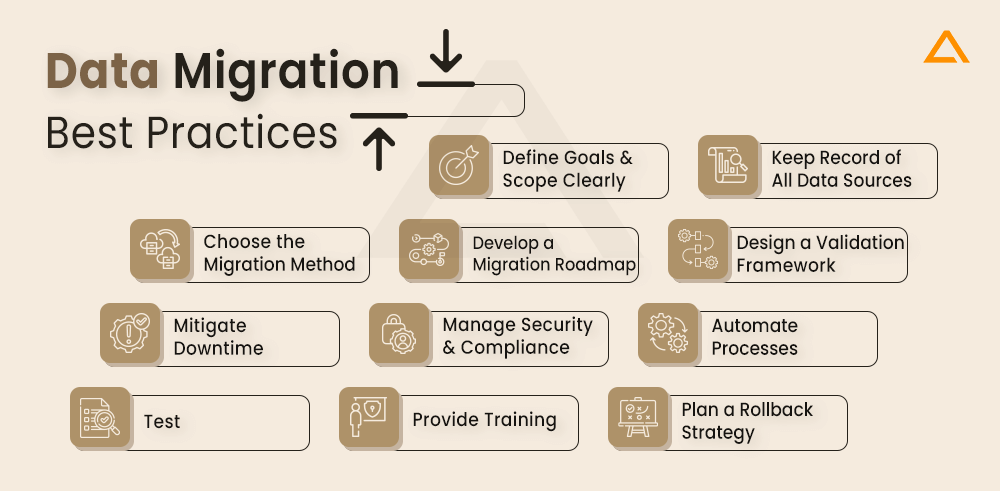
- Define goals & scope clearly – Outline what data is moving, risks, and expected outcomes. Get stakeholder alignment
- Keep record of all data sources – Catalog all systems and databases involved. Document schemas, data types, and interdependencies
- Choose the migration method – Evaluate options like lift-and-shift, ETL, database replication, or hybrid approaches
- Develop a migration roadmap – Include phases, timelines, resources required, and success criteria
- Design a validation framework – Establish tests to verify migrated data’s completeness, accuracy, and integrity
- Mitigate downtime – Minimize disruption by using migration windows, batch transfers, and backup systems
- Manage security and compliance – Implement controls around data security, encryption, and regulatory policies
- Automate processes – Use scripts and tools to reduce manual efforts and increase reliability
- Test, test, test – Conduct trial migrations and rigorous testing before going live. Refine processes
- Provide training – Train staff on new systems and processes to smooth adoption
- Plan a rollback strategy – Have a backup plan ready in case issues emerge during or after migration
Following best practices for thorough planning, validation, and testing is key to effective data migration, reducing risk, and ensuring continuity.
Wrapping Up!
In conclusion, data migration is a strategic effort requiring careful planning and execution. It should have clear objectives, rigorous quality checks, and flexibility to face the challenges. Apart from the physical transfer, it involves optimizing systems for future scalability.
A well-executed migration enhances operational efficiency and data security and positions organizations for agility and competitiveness. Still, if you are unsure which type of data migration is best for you, our data migration services have you covered. Connect with our data migration experts at [email protected], and we will guide you through all the particularities of data migrations.
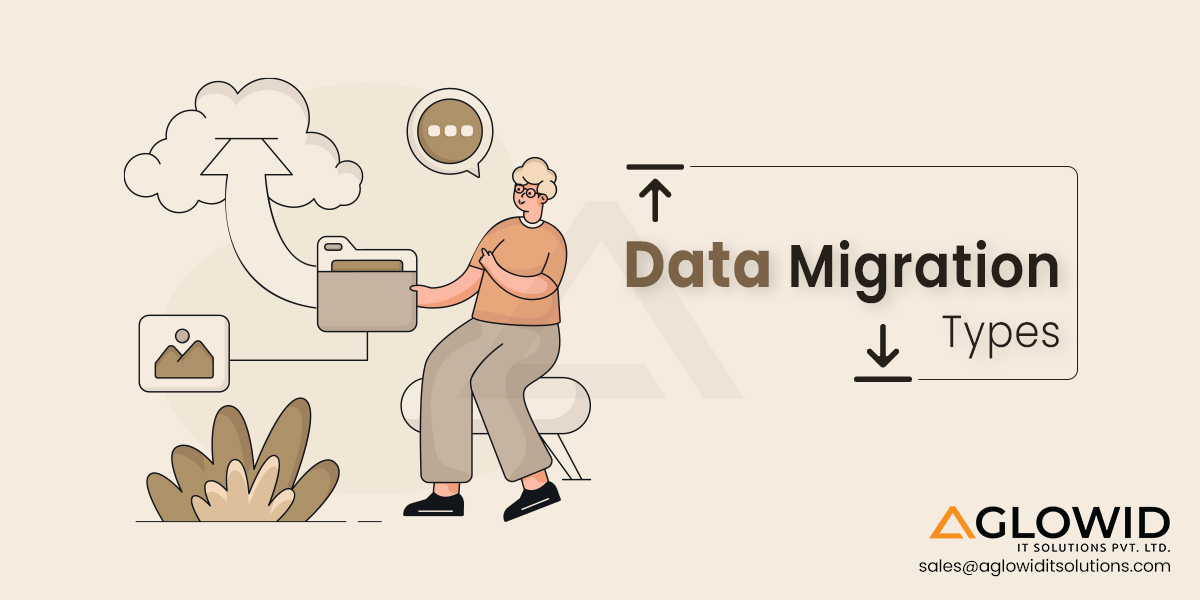

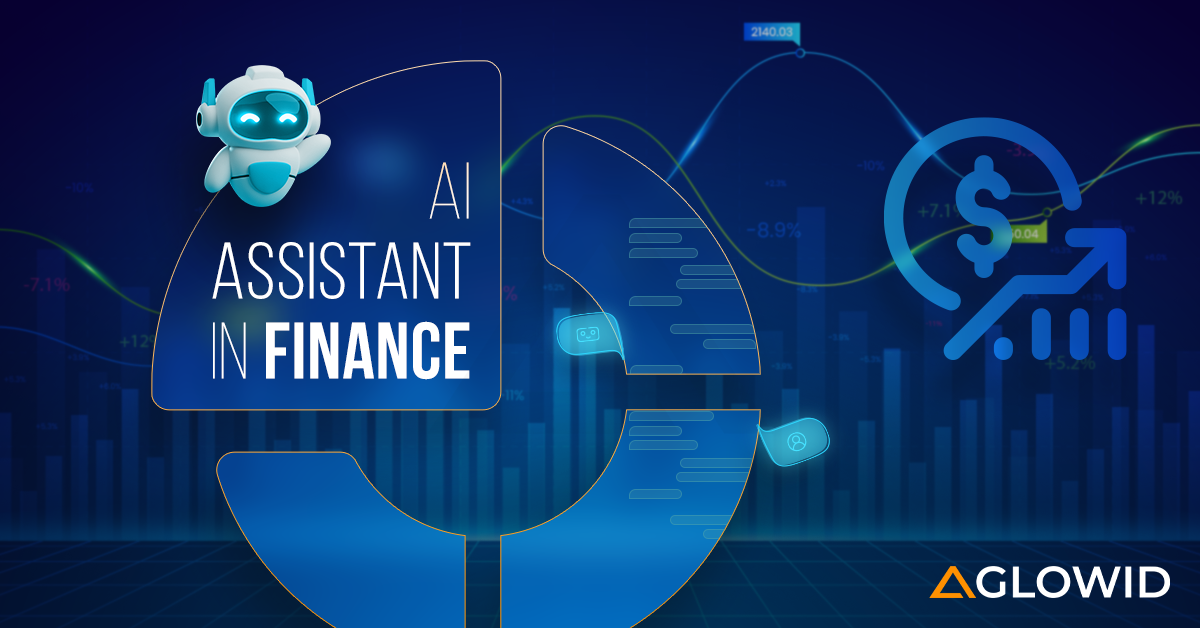
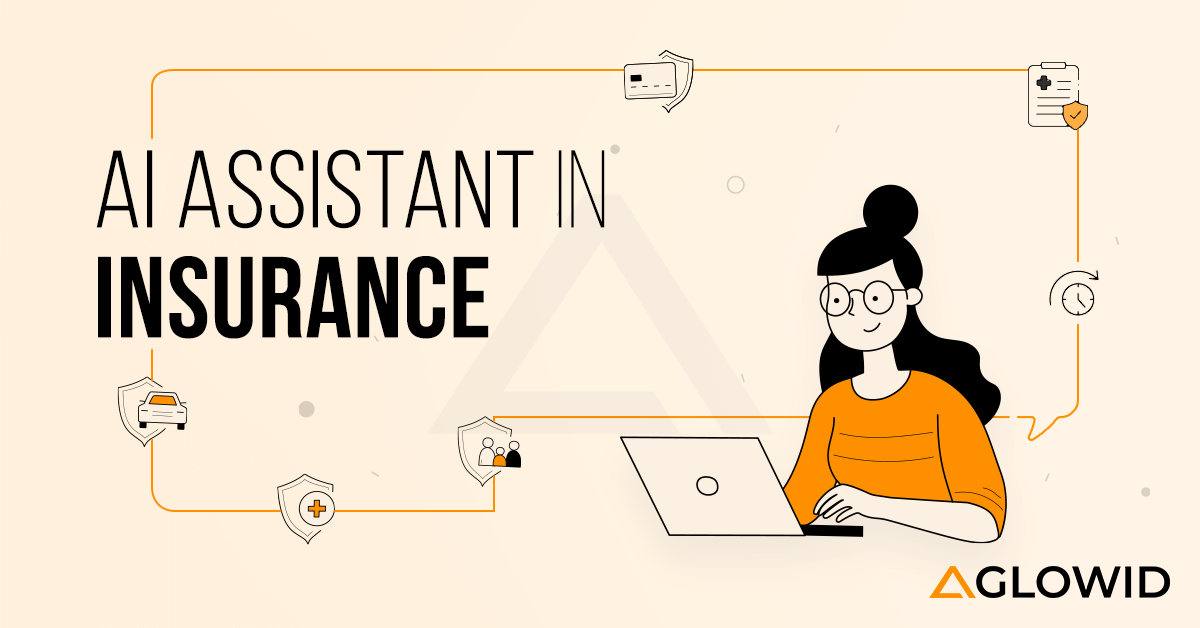

 Say
Say